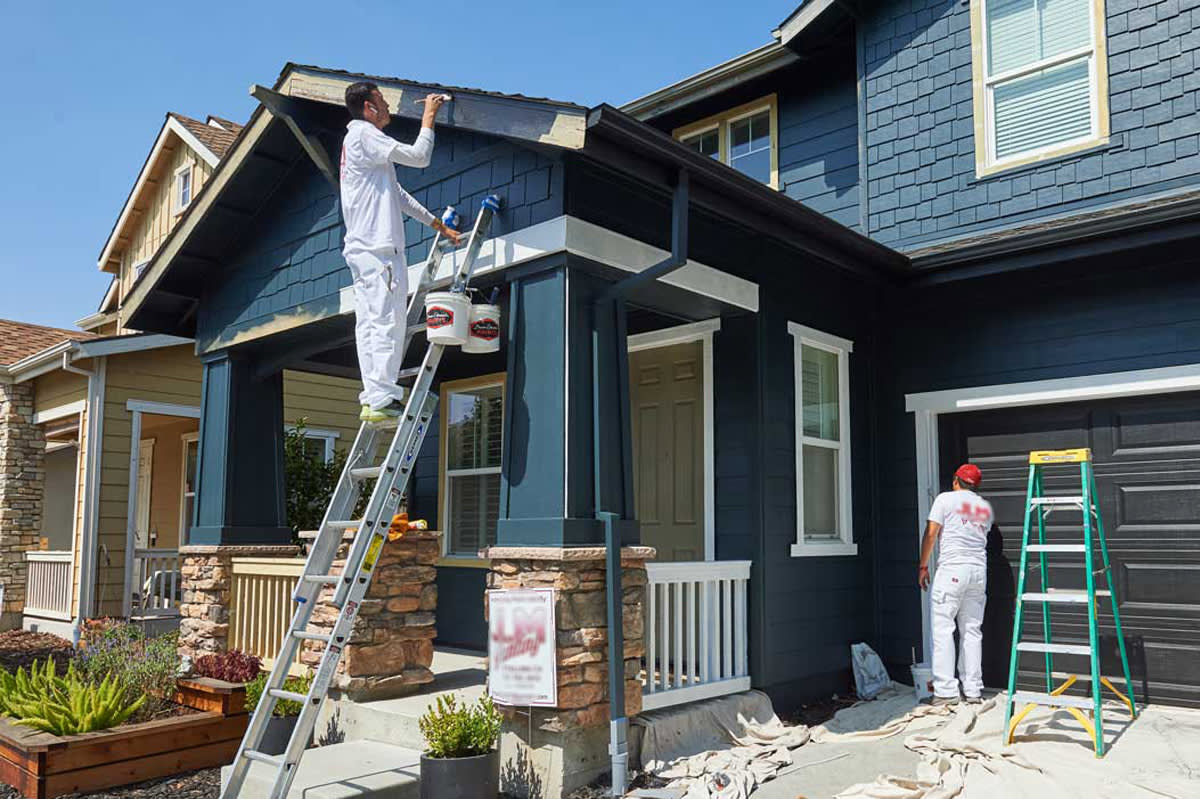Exploring the Different Kinds of Paint: An Overview for each Job
Exploring the various sorts of paint is important for attaining the desired result in any kind of job. From water-based options that use convenience to oil-based paints known for their sturdiness, each choice has its qualities. Specialized paints can include distinct textures or coatings, while green options deal with those looking for sustainability. Comprehending these distinctions can considerably affect the success of a paint venture. What elements should one take into consideration when making the ideal choice?
Understanding Paint Kinds: Oil-Based vs. water-based
Paint kinds can markedly influence a task's result, and comprehending the differences between water-based and oil-based paints is essential for notified decision-making. Water-based paints, often described as latex paints, are composed of water as the main solvent. They completely dry swiftly, discharge fewer unpredictable natural substances (VOCs), and are simple to cleanse up with soap and water. This makes them a preferred selection for indoor applications and settings where air top quality is a worry.
On the other hand, oil-based paints make use of organic solvents, offering a long lasting, glossy coating perfect for surfaces revealed to tear and use, such as trim and closets. They take longer to completely dry, require mineral spirits for clean-up, and have a more powerful smell. corpus christi tx paint shop. Choosing in between these 2 types depends upon the certain demands of the job, considering elements such as wanted coating, application environment, and convenience of upkeep. Each kind has unique benefits and constraints, directing the choice procedure
The End Up Issues: Picking Between Matte, Satin, and Gloss
When choosing a paint coating, the option in between matte and shiny choices substantially influences both looks and capability. Matte surfaces provide a subtle, non-reflective look that can conceal surface area blemishes, while glossy surfaces supply durability and convenience of cleaning. Recognizing the benefits and considerations of each can assist in making an educated choice for any type of painting task.
Matte Finish Benefits
Numerous home owners discuss the benefits of numerous surfaces, matte paint supplies distinctive advantages that make it a popular option for both indoor and outside applications. One of the primary advantages of matte coating is its ability to conceal surface flaws, developing a smoother look on walls. This quality is specifically useful in older homes or rooms with uneven surface areas. Furthermore, matte paint takes in light as opposed to reflecting it, which can improve the aesthetic of a room by providing a much more muted and innovative look. Matte surfaces are typically less complicated to touch up than glossier options, as they can mix extra seamlessly when applied over existing paint. Generally, matte paint is a superb selection for those seeking a fine-tuned and stylish finish.
Shiny Complete Factors To Consider
A glossy finish can dramatically change the assumption of a space, using a streamlined and reflective quality that improves both shade vibrancy and light within an area. This coating is frequently preferred for high-traffic locations and surface areas like bathroom and kitchens, where toughness and convenience of cleaning are important. Nevertheless, its reflective nature can highlight flaws on wall surfaces, making correct surface area prep work critical. Glossy paints likewise often tend to reveal spots and finger prints quicker, demanding normal upkeep. In addition, lights plays a substantial duty; in intense settings, a shiny surface might produce glare, affecting the overall aesthetic. Consequently, mindful factor to consider of the certain application and atmosphere is necessary when choosing a glossy coating for any kind of job.
Specialty Paints: When to Make Use Of Distinctive or Chalk Paint
Specialty paints, such as distinctive and chalk paint, deal distinct visual and sensible benefits that can enhance numerous surfaces. Distinctive paint is excellent for producing depth and measurement on wall surfaces, concealing blemishes while including a three-dimensional feel. It is specifically helpful in high-traffic areas where durability and aesthetic rate of interest are important.

Both types of specialty paints can transform rooms, but selecting the appropriate one depends on the desired effect and surface area needs. Distinctive paint might suit bigger locations, while chalk paint can renew smaller items, showcasing imagination and personal design in any kind of job.
Exterior Paints: Protecting Your Surface Areas From the Aspects
Outside paints are important for safeguarding surface areas versus various weather. Comprehending their weather resistance functions, correct surface area preparation demands, and efficient application techniques can substantially improve sturdiness and performance. This area will lay out crucial considerations for choose and utilizing exterior paints successfully.
Weather Resistance Includes
Weather condition resistance is an important attribute of outside paints, as it establishes exactly how well surface areas can endure the harsh aspects of nature. High-quality exterior paints are formulated to withstand damage from UV rays, wetness, and temperature level fluctuations. UV resistance warranties colors continue to be vibrant gradually, avoiding fading and staining. Moisture resistance shields against mold and mildew and mold, which can jeopardize the honesty of surfaces. Additionally, paints with superb temperature level resistance can acquire and expand without cracking, keeping their protective qualities. When choosing exterior paints, it is vital to take into account these climate resistance features, as they contribute to the durability and durability of painted surface areas, making particular they stay cosmetically pleasing and functional despite exposure to the components.
Surface Area Preparation Demands
Correct surface area preparation is an essential action in attaining the best results with exterior paints. To guarantee optimal attachment and toughness, surface areas should be completely cleaned, removing dirt, grease, and mold. This can be achieved utilizing a stress washing machine or a scrub brush with an ideal cleansing option. Once cleaned, surface areas need to be evaluated for any kind of peeling or flaking paint, which have to be scratched away to develop a smooth structure. Fixing any kind of fractures or holes is additionally important, as these can allow moisture infiltration. Additionally, sanding rough locations promotes far better paint attachment. Using a guide suited for outdoor usage can boost the paint's efficiency, assuring a long-lasting finish that holds up against the components. Proper prep work is vital to a successful outdoor paint project.
Application Strategies Tips
While applying exterior paints, it is vital to use effective strategies that guarantee surface areas are well-protected against the components. First, pick the best day for paint; reduced humidity and moderate temperatures improve adhesion and drying. Prepping the surface area thoroughly-- cleansing, sanding, and priming-- makes sure better paint bond and sturdiness. Making use of top notch brushes or rollers can provide a smoother surface, while spray paint may cover big locations efficiently. Applying paint in slim, even layers avoids runs and drips. It is recommended to comply with manufacturer directions relating to drying times in between coats. Lastly, confirm correct ventilation during application to assist in drying out and minimize exposure to fumes. These strategies greatly improve the durability and performance of exterior paint.
Eco-Friendly Options: Low-VOC and Zero-VOC Paints
As consumers become progressively familiar with the ecological influence of their choices, low-VOC and zero-VOC paints have arised as preferred choices. These paints are formulated to include fewer unstable natural substances (VOCs), which are chemicals that can vaporize right into the air and contribute to air pollution and illness. Low-VOC paints usually have a minimal quantity of VOCs, while zero-VOC paints have minimal degrees, making them more secure for both exterior and interior usage.
The benefits of utilizing low-VOC and zero-VOC paints prolong beyond environmental considerations; they also boost interior air top quality, reducing the threat of sensitive responses and respiratory system issues. Many manufacturers currently supply a selection of shades and coatings in eco-friendly options, more info making it easier for consumers to find suitable products for their projects. By selecting these paints, people can contribute to a healthier setting while still accomplishing the aesthetic they want in their rooms.
Devices and Strategies for a Perfect Application
Achieving a flawless paint application calls for the right devices and strategies, which can substantially improve the final result. Choosing the suitable brush or roller is necessary; brushes function well for edges and elaborate areas, while rollers cover bigger surfaces successfully. Utilizing high-quality products guarantees far better paint distribution and decreases streaks. For ideal outcomes, surface prep work is necessary. This includes cleansing, fining sand, and priming surfaces to advertise bond.
Technique likewise plays a significant duty. The "W" technique with a roller aids to uniformly disperse paint, while long, smooth strokes with a brush stop visible lines. Operating in sections enables better control and mixing. Additionally, using slim coats is more suitable to thick layers, lowering the danger of drips and irregular textures. Lastly, maintaining a wet edge throughout application helps accomplish seamless adjustments in between areas. By integrating these tools and techniques, one can accomplish a expert and refined coating.
Tips for Preserving and Caring for Your Painted Surfaces
Correct upkeep and treatment of painted surfaces can substantially extend their lifespan and protect their look. Normal cleansing is vital; making use of a soft towel or sponge with mild soap and water can eliminate dust and dirt without damaging the paint. It is recommended to avoid abrasive cleaners or rubbing pads, as these can damage the surface. Additionally, applying a fresh coat of paint every few years can revitalize the shade and secure versus wear.
For outside surface areas, evaluating for indicators of peeling off or fading consistently is important. Promptly dealing with any type of issues avoids additional damages. In locations susceptible to wetness, such as restrooms, using mold-resistant paint and guaranteeing proper ventilation can aid keep the stability of the paint. Using safety surfaces can protect against UV rays and stains, ensuring that repainted surfaces continue to be attractive and dynamic for years to come, inevitably improving the overall visual of the space.

Often Asked Concerns
Can I Mix Different Kind of Paint With Each Other?
Blending different sorts of paint is typically not suggested, as it can bring about concerns like inadequate adhesion, inconsistent appearance, or unanticipated chemical reactions. It's finest to make use of compatible paints for suitable results and longevity.

How Do I Properly Store Extra Paint?
To correctly save leftover paint, seal the container securely, tag it with the date and color, and keep it in a great, completely dry place away from direct sunshine and severe temperature levels for perfect preservation.
What Is the very best Means to Get Rid Of Extra Paint?
The most effective way to deal with extra paint is to examine neighborhood regulations, as numerous areas have marked contaminated materials centers. Take into consideration giving away useful paint to community companies or colleges for their tasks.
Just How Can I Inform if Paint Is Still Excellent to Make Use Of?
To determine if paint is still good, analyze its consistency, scent, and color. If it shows up apart, has an unpleasant odor, or reveals substantial modifications in structure, it's likely no longer useful.
Exist Age Restrictions for Investing In Paint Products?
In lots of regions, there are no specific age constraints for acquiring paint items. However, some stores might need customers to be at the very least 18 years of ages, especially for products containing solvents or unsafe products.
Paint types can considerably influence a job's outcome, and recognizing the differences in between water-based and oil-based paints is important for informed decision-making. Water-based paints, often referred to as latex paints, are made up of water as the main solvent. In contrast, oil-based paints make use of organic solvents, offering a sturdy, shiny finish perfect for surfaces revealed to use and tear, such as trim and cupboards. Specialty paints, such as textured and chalk paint, offer special visual and useful advantages that can enhance numerous surfaces. In locations vulnerable to wetness, such as washrooms, utilizing mold-resistant paint and ensuring correct ventilation can aid maintain the stability of the paint.